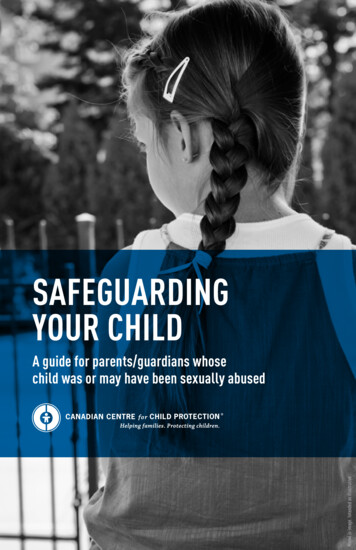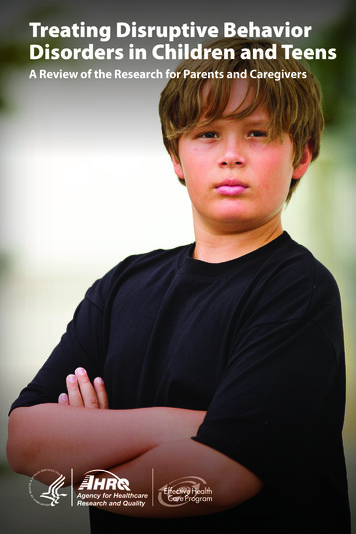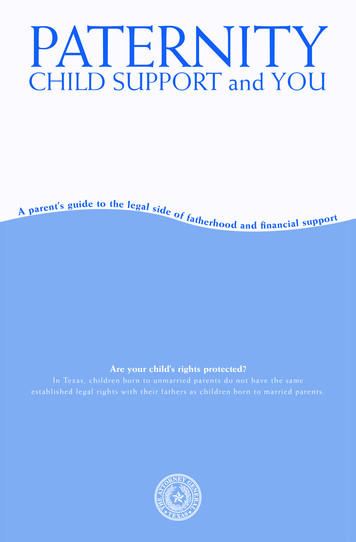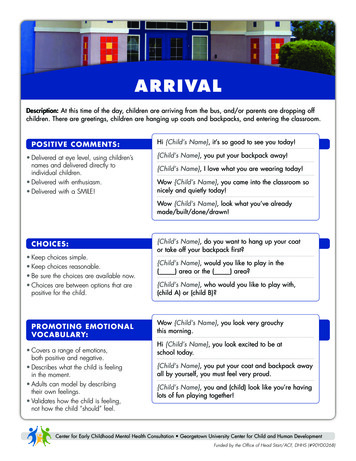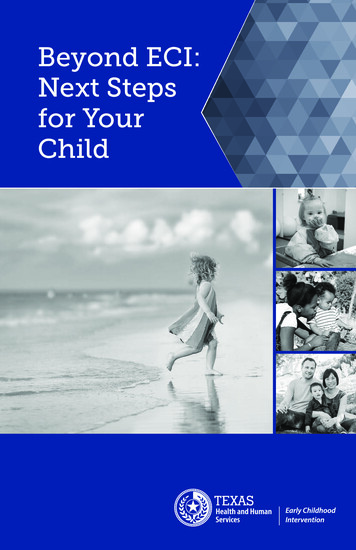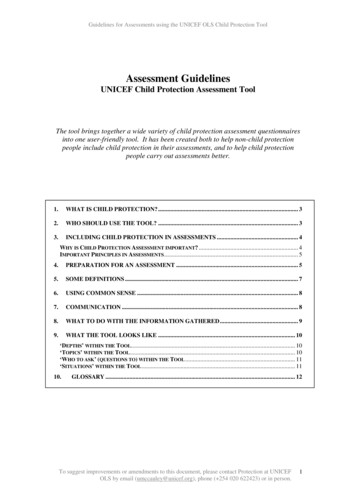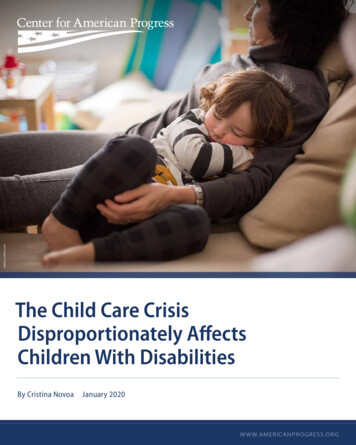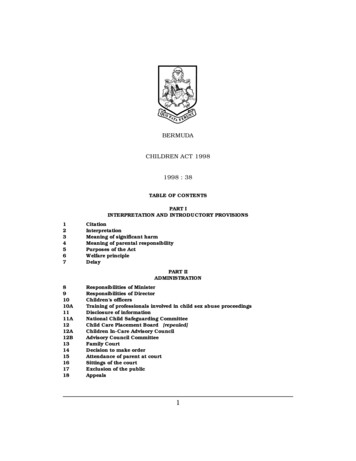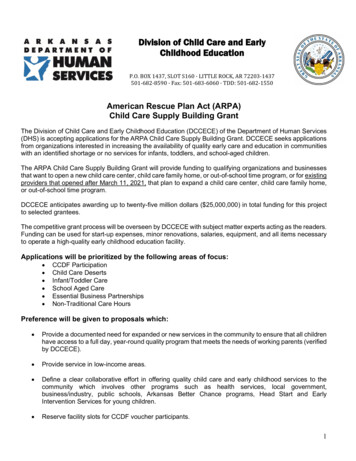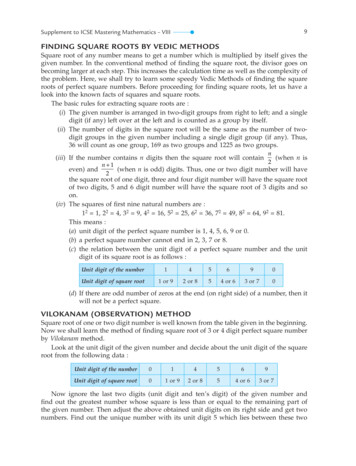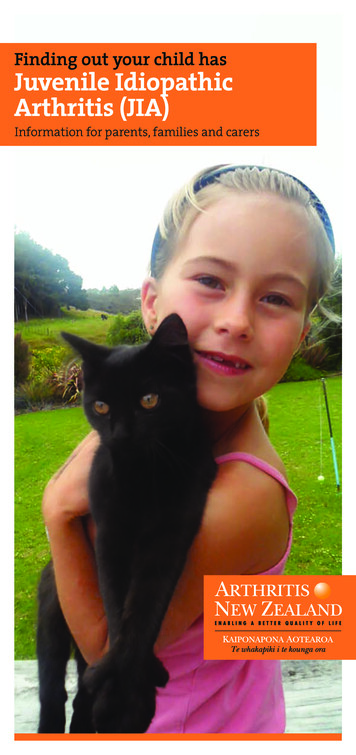
Transcription
Finding out your child hasJuvenile IdiopathicArthritis (JIA)Information for parents, families and carers
Jetstar Flying Start Ambassador Steve Price with TamsinTaylor and Jennifer McNaughtonDid you know? Juvenile Idiopathic Arthritis (JIA) is a relativelyuncommon condition. It affects around 1 in1,000 children. JIA is more common in girls than in boys. At least half of children with JIA won’t have anysymptoms by the time they become adults.2
JIA is a type of arthritis that occurs in children aged 16or younger. ‘Juvenile’ means that young people get thistype of arthritis. ‘Idiopathic’ means that we don’t knowwhat the exact cause is. ‘Arthritis’ means inflammation ofjoints; it causes joint swelling, stiffness and pain. JIA is achronic condition and it lasts more than six weeks.Causes of JIAThe cause of JIA is unknown. JIA is not consideredhereditary and rarely involves more than one familymember. Research suggests that some genes andenvironmental triggers, such as an infection can playa role in the development of JIA.ContentsPage What happens in Juvenile Idiopathic Arthritis?4 Types of Juvenile Idiopathic Arthritis6 Symptoms of Juvenile Idiopathic Arthritis;What is uveitis?8 Diagnosis9 Management and treatment options10 Medications12 Excercise; The importance of rest14 Pain Manamgement; Nutrition15 Psychological support16 Questions to ask your rheumatologist17 How I can help my child; Key points18 Where can we get more information and support? 193Juvenile Idiopathic Arthritis www.arthritis.org.nzWhat is Juvenile Idiopathic Arthritis(JIA)?
What happens in Juvenile IdiopathicArthritis?JIA is an autoimmune condition where, for unknownreasons, the immune system becomes confused andattacks normal healthy cells of the body.In healthy joints, synovial membranes surroundingthe joints produce fluid that provides nutrition to thecartilage as well as lubrication and cushioning to theconnecting bones. In JIA the synovial membranes becomeinflamed, producing more fluid and joints may becomeswollen, painful and stiff. If inflammation is not treated,it can damage the joint, the cartilage and the bone.Muscles around the joint can become weak and the jointmay not be able to move as well as usual.Common areas affected by s4
Over 1,000children inNew Zealandhave JIA.
Types of Juvenile Idiopathic ArthritisJIA includes eight different types of arthritis, the mostcommon are: oligoarticular and polyarticular.Oligoarticular JIA: Most common type of JIA affecting about 50-60percent of children with arthritis Often begins between 2 and 4 years of age Is more common in girls than in boys Initially can affect four joints or less. About 20-30percent of children will develop more than 4 inflamedjoints after 6 months Children with this type of arthritis can develop eyeinflammation (iritis or uveitis). This usually has nosymptoms, so regular eye checks are important.Polyarticular JIA: Affects 20-30 percent of children with arthritis Is more common in girls than in boys Can begin at any age Affects five or more joints.There are two types of polyarticular JIA based on whetherthe Rheumatoid Factor (RF) is found in the blood.About 5 percent of children with polyarticular JIA are RFpositive. This form more commonly affects teenage girlsand is more likely to continue into adulthood.6
Systemic JIA: Affects about 10 percent of children with arthritis Effects boys and girls equally It usually involves fevers and rashes May cause inflammation of the internal organs.Psoriatic arthritis: Is associated with psoriasis – a scaly skin conditionwhich may also involve the nails. The arthritis may be in any number of joints.Enthesitis-related arthritis (ERA): Involves both arthritis and inflammation in the spine. Joint pain can be without obvious swelling Children may complain of back pain and stiffness.Need a caption here as these are ‘real people’.7Juvenile Idiopathic Arthritis www.arthritis.org.nzLess common types
Symptoms of Juvenile IdiopathicArthritisSigns and symptoms of JIA change over time, sometimeseven day to day. Times without symptoms (remissions)followed by a reappearance of symptoms (‘flare-ups’).Symptoms may include: pain, stiffness, swelling, especially in the morning, anda joint that feels warm to the touch limping or “going off their feet” fatigue loss of appetite loss of weight high fever and skin rash (systemic JIA) swelling in lymph nodes in the neck and other parts ofthe body.JIA can also cause bones to grow unevenly.What is uveitis?Uveitis is inflammation of parts of the eye, including theiris (the coloured bit of the eye) and the muscles andtissues that focus the eye. It doesn’t hurt, and it is hardto tell if there is inflammation just by looking at the eye.However if uveitis is not treated it can cause vision loss.It is very important to have regular check-ups with anophthalmologist (specialist eye doctor) to check if thereis inflammation in the eyes.8
If JIA is suspected, the child should be referred toa Paediatrician, who will liaise with a Paediatricrheumatologist. There is no single test to confirm adiagnosis of JIA, and reaching a diagnosis may take time.This can be very frustrating for families.The diagnosis of JIA is based on medical history, physicalexamination, laboratory tests, x-ray and other tests.Medical investigations may include: Blood tests:ÆÆFBC (Full Blood Count) – a blood test to check foranything abnormal that might be important indiagnosis and managing the illness.ÆÆRF (Rheumatoid Factor) – an antibody detectedby a blood test. This can be useful in deciding ontreatments for JIA.ÆÆErythrocyte Sedimentation Rate (ESR) andC-Reactive Protein (CRP) are tests that show howmuch inflammation there is in the body.ÆÆANA (Anti-Nuclear Antibody) is an importantindicator for your child’s risk of developingeye problems. X-rays of the affected joints are usually needed toallow the doctor to look for any joint damage. Ultrasound and magnetic resonance imaging (MRI)scans are other ways to look at the soft tissuestructures of the joints for signs of inflammation. Aspiration of a joint is where the fluid from a swollenjoint is removed to be tested in a lab, to check forpossible infection.Some tests maybe ongoing or have to be repeated severaltimes. This helps the doctor look for changes to yourchild’s symptoms over time.9Juvenile Idiopathic Arthritis www.arthritis.org.nzDiagnosis
Management and treatment optionsThe overall goal of managing JIA is for your child andfamily to lead as normal a life as possible. A team ofhealth professionals will provide a range of treatmentsand support to make sure that your child leads an activeand enjoyable life. The make-up of your child’s team willdepend on how the illness is impacting on your child’swell-being.Your child’s Paediatrician will coordinate this team.This team may include: Paediatric rheumatologist or adult rheumatologist GP Physiotherapist Nurse Occupational Therapist Ophthalmologist (specialist eye doctor) Podiatrist/orthotics service Dietician Pharmacist Arthritis Educator Social worker Psychologist or counsellor Teachers.Take guidance from all members of the team so together,you can make the best decisions for your child.10
I couldn’tbelieve theGP’s diagnosis!
Treatment for JIATreatment for JIA might include: medications to control the pain and inflammation exercises to keep the joints moving well andmuscles strong strategies to help with pain social and psychological support.Medications1. Pain relievers (analgesics)Pain relievers or analgesics include paracetamol(Panadol). Other stronger pain relievers are also availableand can be prescribed by your GP or specialist whenrequired. Pain relievers can help your child feel morecomfortable, be more active and sleep better. Painrelievers do not reduce inflammation, and can be usedwith other drugs like Non-steroidal anti-inflammatorydrugs (NSAIDs).2. Non-steroidal anti-inflammatory drugsNSAIDs such as Naproxen, Indomethacin and Celecoxibreduce inflammation and help control the symptomscaused by JIA, such as stiffness and swelling. They canmake your child feel better but they don’t cure JIA. Themost common side effect of NSAIDs is stomach upset.Do not give your child any additional over-the-counterNSAIDs, only those prescribed.12
DMARDs such as Methotrexate, can slow or stop theprogression of JIA by reducing the activity of the immunesystem, which is overactive in JIA. They are often used incombination with an NSAID. These medicines can takeseveral months to reach their maximum effectiveness.Your child will be monitored for side effects while takingthis medicine.Because DMARDs reduce the activity of the immunesystem, some children are more likely to catch infections.Because of this, live virus vaccinations e.g. oral polio,varicella (chicken pox) and measles, mumps, rubella)should not be given while your child is on DMARDs.4. CorticosteroidsCorticosteroids are hormones that are produced naturallyin the body by the adrenal glands. When given as amedicine, corticosteroids can provide rapid and powerfulreduction of pain and inflammation in children with JIA.Steroids can be given in various forms. In JIA theyare most commonly given by injections into theinflamed joints.5. Biological Therapies (biologics)Biological Therapies is a name given to some newervery effective drugs that have been available for about10 years. Etanercept, Adalimumab and Tocilizumab arefunded for JIA in New Zealand. These medications areonly used for children with JIA that is not controlled byDMARDs. Biologics slow down the progress of arthritis,and reduce pain, swelling and stiffness. Like DMARDsthey work by suppressing the immune system, and13Juvenile Idiopathic Arthritis www.arthritis.org.nz3. Disease modifying anti-rheumatic drugs(DMARDs)
inhibiting the body’s over production of inflammatorysubstances such as TNF alpha. Children on biologics aremonitored for side effects. Some children are more likelyto catch infections, live virus vaccines should not be givenwhile your child is on this therapy.*Remember to let your doctor know about other prescribedmedications or natural therapies that your child is takingas they may interact with their arthritis medications.ExerciseExercises are important to keep muscles and bonesstrong. Exercise can also help to reduce the pain ofJIA. Your child’s physiotherapist can advise on suitableexercises for your child. Swimming is excellent, it allowsgreater freedom of movement and it’s fun.The importance of restJIA can cause tiredness, so it is important that your childgets a good night’s sleep and maybe some rest duringthe day. Alternating between active and passive activitiessuch as listening to music, reading a book may help toreduce fatigue.14
There are many strategies that can help children copewith pain. It is important for you and your child to learnthese strategies such as deep breathing, imagery andrelaxation and practice them regularly. You can also tryhot and cold packs, massage and distraction.NutritionChildren with JIA can have trouble with their appetite,so make sure your child is eating enough to maintain ahealthy weight and good energy levels. A balanced dietis key, so include plenty of fresh fruit and vegetables, aswell as calcium-rich foods like milk, cheese and yogurt inyour meals.15Juvenile Idiopathic Arthritis www.arthritis.org.nzPain management
Psychological supportMost children with JIA grow up to be well roundedpeople living active lives. However if JIA is achallenge for your child and your family it may helpto be referred to a psychologist or other supportservices to learn skills and strategies to cope withfeelings, pain, or relationships.There are support groups that provide informationand support to families with children with JIA such asArthritis New Zealand and Kids with Arthritis NewZealand (KWANZ).16
Having good information and understanding of JIA andmedications is important in managing this conditionand supporting your child. If you don’t feel that you arefully informed or have concerns about the medicinesbeing used for your child don’t be afraid to discuss thesewith the doctor who prescribed the medicine. It may behelpful to write down your questions as you think ofthem, rather than trying to remember them at the nextappointment. If you are well prepared you will gain themost information from each appointment.Questions toask your Doctor: Why is this medicine needed andhow it can benefit my child? How doesit work? How should the medicine be taken(the dose, frequency, etc.)? What sideeffects can ithave andwhat to do ifthey occur? What tests (if any) areneededwhile takingthis medicine? How longdoes it take toachievethe maximum benefit? How longwill my childneed to stayon the medicine? When andhow will you(thedoctor) reviewthe progressofthe medicine?17Juvenile Idiopathic Arthritis www.arthritis.org.nzQuestions to ask your rheumatologist
How I can help my child?Well informed, supported and supportive parents aregreat role models and advocates for their children witharthritis. They will, together with the treatment team,help their child learn about their illness, form healthyroutines with medications and think positively aboutlife, family relationships, friendships, their educationand growing up.Key points:1. JIA can vary from child to child; your doctorwill create a treatment plan tailored specificallyfor our child.2. Be prepared for ‘flares’ – know how to recogniseand manage a flare.3. Encourage your child to participate in normalactivities e.g. sports, crafts, music.4. Explain to family, friends and teachers atyour child’s school what JIA is and how itmight impact on your child’s daily life.5. Encourage maintenance of school attendanceand normal childhood routines.6. Write down questions as you think of them,ready for the next time you talk with your child’shealthcare team.7. Most importantly, don’t be afraid to reach outfor help and support.18
Juvenile Idiopathic Arthritis www.arthritis.org.nzWhere can we get more informationand support? Arthritis New Zealand – www.arthritis.org.nz andToll free 0800 663 463 KWANZ – Kids with arthritis support group –www.kidswitharthritis.org.nz Royal Childrens’Hospital Melbourne –www.rch.org.au/rheumatology/information aboutrheumatological conditions/ Arthritis Research UK on/conditions/juvenile-idiopathic-arthritis.aspx Arthritis Care – ies19
Where can I learn more?www.arthritis.org.nzRegional officesNorthern (Auckland) 09 523 8900Midland/Central (Wellington) 04 472 1427Southern (Christchurch) 03 366 8383National officeLevel 2, 166 Featherston StreetPO Box 10020, The TerraceWellington, 6143Phone 04 472 1427Fax 04 472 7066Tollfree 0800 663 463Proudly sponsored by:Arthritis New Zealand is the registered trade name for Arthritis Foundation of New Zealand IncorporatedCharity number CC22132jia.016/August2013Follow us on
Children with this type of arthritis can develop eye inflammation (iritis or uveitis). This usually has no symptoms, so regular eye checks are important. Polyarticular JIA: Affects 20-30 percent of children with arthritis Is more common in girls than in boys Can begin at any age Affects five or more joints.
